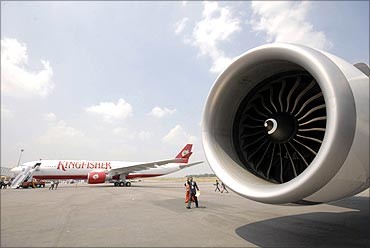
Capacity addition may not be enough for Mallya to claw his way back after losing ground to Bhatia's carrier, analysts say.
For some time, frequent fliers with Kingfisher Airlines (KFA) have been left wondering: "Why are we paying a premium when the service offered by the airline is just about the same as any other airline?"
"It is a 'five-star' airline, but some of the amenities that got it the five-star rating are slowly giving way. It is time Kingfisher pulled up its socks and improved the service," said a Kingfisher Airlines frequent flier.
It's not surprising then that Kingfisher is losing its ground to IndiGo Airlines, which is now jointly at the second spot with Kingfisher in terms of market share.
...

Though Kingfisher maintains that grounding of 14 of its aircraft is the sole reason for a fall in its market share, industry analysts believe market share is not just about capacities.
"On-time performance is no longer a luxury, it is a necessity. On-time service, too, is said to have helped IndiGo become the second-biggest airline. People fly to be on time and for point-to-point travel. IndiGo seems to have got its fundamentals right," says Amber Dubey, director (aerospace & defence) at global consultancy firm KPMG.
IndiGo has used its aircraft efficiently. During December, its seat load factor stood at 93.3 per cent, compared to Kingfisher's 85.9 per cent.
With the Directorate General of Civil Aviation (DGCA) asking the air traffic controllers to be strict on implementation of timetable, if an airline is not on time, it is pushed to the end of the queue. And, if a flight is delayed, there has to be a cascading effect.
...
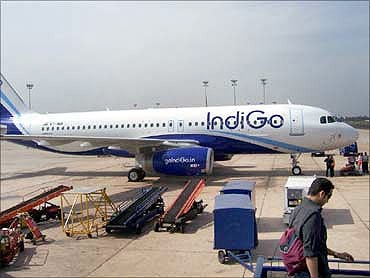
IndiGo could use one aircraft for up to four flights a day. Of the 5.21 million passengers flying in December, IndiGo carried about 971,000, grabbing 18.62 per cent of the market share and becoming the second-largest domestic airline in the country in terms of passengers carried.
Its closest competitor had carried about 972,000 passengers in the month, which accounted for 18.64 per cent of the market.
"IndiGo has grown 42 per cent over the same period last year, while its nearest competitor has grown about 4 per cent. The Indian aviation sector is expected to grow to about 57 million passengers in 2011, IndiGo airlines has built a strategy to capture the bulk of air travellers in the country," said John Siddharth C P, industry analyst (aerospace & defence) for South Asia and West Asia at Frost and Sullivan.
Another analyst with a Mumbai-based brokerage house said a control on the pricing front was another factor working in IndiGo's favour.
...
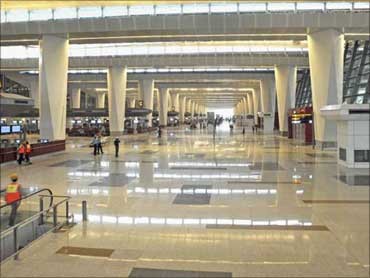
"We expect IndiGo to gain market share, as it has plans to add 10 aircraft to its fleet next financial year. This would be an addition of about 33 per cent to its present capacity," he added.
An unexpected blessing for IndiGo had been the new Terminal 3 (T3) at the Indira Gandhi International Airport in New Delhi. With T3 becoming operational, Kingfisher and Jet moved to the new terminal, while IndiGo continued to operate from the D1 terminal.
Since about 49 per cent of the traffic had moved out, the old terminal had become less crowded. This seemed to be favourable for IndiGo, said a regular flier.
Devesh Agarwal, an independent aviation analyst, said IndiGo had a single-minded operational focus on keeping costs low, which provided a simple, uncluttered, punctual and quite error-free travel experience for its passengers.
...
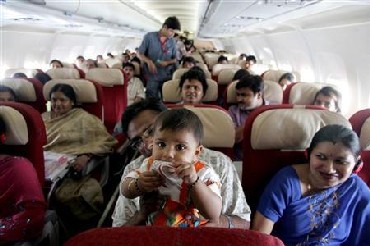
"Bruce Ashby (IndiGo's former CEO) set a strong foundation at the inception of the airline and this has continued and deepened. For short-haul operations (less than four hours) this is the correct formula, also followed by world leaders like Southwest and AirAsia. The airline leadership also relies on some very innovative and radical methods of airline back-end operations like financing, leasing, etc", Agarwal said.
In comparison, according to Agarwal, Kingfisher drifted in its focus. This caused financial difficulties for it.
"With the new leadership in place, Kingfisher does have a chance to recover, but it is an uphill task," he added.
Besides clawing its way back in market share and beefing up its network, Kingfisher would also have to actively work on reducing its debt burden to increase productivity.
...

"Though there is a capacity addition plan, Kingfisher has to take care of the debt level for higher operational efficiency," the Mumbai-based analyst said. He added that Kingfisher might slip from its present position due to resurgence of low-cost carriers.
However, not everyone is ready to join the criticism bandwagon. Some believe that capacity addition will indeed have a good effect on Kingfisher.
"While the industry is expected to grow around 15 per cent in 2011-12, capacity addition of over 15 per cent in case of Kingfisher will make its position steady," an analyst said.
Further, the planned Global Depositary Receipt of Kingfisher of around $250 million is expected to ease pressure on its balance sheet and help the airline improve efficiency.
...

The company is even looking at some rationalisation within its present organisation to reduce operational expenditure. This could help the company invest more in capacity addition.
A Kingfisher Airlines spokesperson said 7 out of the 14 grounded aircraft were now flying and the rest would start flying by the end of March.
"This means that Kingfisher Airlines' deployed capacity will effectively increase 40 per cent, and our market share will follow suit. Our share declined solely due to 14 grounded Airbus aircraft. That's 40 per cent of IndiGo's and 60 per cent of SpiceJet's capacity. We expect Kingfisher's market share to pull ahead strongly with capacity restoration and planned capacity increase," he added.
"Ours is the best and the most awarded brand for its service, so the share increase is not going to be a challenge. We will restore many routes where we were forced to pull out due to our aircraft-on-ground situation," the spokesperson added.
...
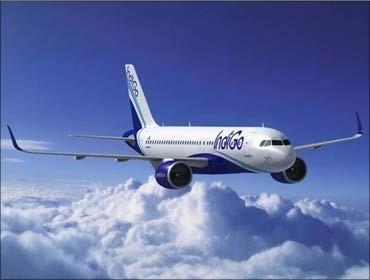
Agarwal, however, felt volume was not necessarily the name of the game, and domestic passenger share was certainly not the final benchmark.
"Look at Virgin Atlantic or Singapore Airlines. They have a fantastic product, command a premium on fares, are extremely profitable, but still do not dominate. Kingfisher has stabilised its international operations and its entry into the Oneworld Alliance will stand it in good stead, provided it gets its fair share of benefits in return. The recently-announced code-share partnership with American Airlines, however, does not reflect a balanced benefit for the airline," he added.
Going ahead, Kingfisher may well be up against the aggressive competition from IndiGo, as it is set to launch its international operations during the year and is embarking on a $15-billion order to Airbus for 150 new aircraft.
With contributions from Debasis Mohapatra & Raghuvir Badrinath.